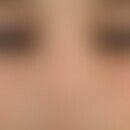DefinitionThis section has been translated automatically.
Vulvovaginal-gingival syndrome, also called "vulvovaginal-gingival lichen planus", in short VVG-LP, is a distinct clinical subtype of lichen planus and consists of the following triad: vulvar, vaginal and gingival lichen planus lesions. In most patients (75%), the scalp is also affected (lichen planus follicularis). Due to the complicating late sequelae (vulvar and vaginal fibrosis, alopecia), the affected patient population requires special medical care.
EtiopathogenesisThis section has been translated automatically.
An autoimmunological genesis can be assumed. In about 30% of the patients with a "vulvovagino-gingival syndrome" autoimmunological "concomitant diseases" such as diabetes mellitus, Hashimoto thyroiditis (15%), vitiligo (5%), alopecia areata (4%), celiac disease, pernicious anemia, Sjögren's syndrome, idiopathic thrombocytopenic purpura are found.
A genetic predisposition has been discussed in this group of patients: there are relationships with the HLA phenotype DQB1 (Setterfield JF et al. (2006).
You might also be interested in
ManifestationThis section has been translated automatically.
The mean duration of the disease is > 10 years (3-31 years).
In a larger collective of lichen planus patients, this constellation was present in exactly 10% of cases. In 75% of these patients, the scalp was also affected (Olszewska M et al. (2016).
TherapyThis section has been translated automatically.
In addition to local therapeutic measures (see below Lichen planus mucosae), the initial weight-adapted use of azathioprine (e.g. Imurek) 1.5-2.0 mg/kg bw/day p.o. is recommended, if necessary in combination with a glucocorticoid in an initial medium dosage (e.g. prednisolone 0.5 mg/kg bw/day p.o.). Subsequently symptom-adapted lower dosage (5.0-7.5 mg/day p.o.).
Alternative: Ciclosporin A (1.0-5.0 mg/kg bw/day).
Alternative: MTX 15mg s.c./week, if necessary switch to oral therapy and lower MTX dosage (2.5mg/oral/week) in a symptom-adapted manner.
It is foreseeable that this therapy must be followed over a longer period (>6 -12 months). The patient must be instructed regarding the necessary 4-weekly laboratory checks. Clinical monitoring with regard to a mycotic overgrowth(yeast diagnostics) is important.
LiteratureThis section has been translated automatically.
- Carbonari APC et al. (2018) Esophageal lichen planus: An unusual cause of dysphagia in the elderly. Rev Assoc Med Bras 64:214-216.
- Eisen D (1994) The vulvovaginal-gingival syndrome of lichen planus. The clinical characteristics of 22 patients. Arch Dermatol 130:1379-182
- Moutasim KA et al (2008) A case of vulvovaginal gingival lichen planus in association with Good's syndrome. Oral Surg Oral Med Oral Pathol Oral Radiol Endod 105:e57-60.
- Panagiotopoulou N et al (2010) Vulvovaginal-gingival syndrome. J Obstet Gynaecol 30:226-30.
- Olszewska M et al. (2016) Vulvovaginal-gingival lichen planus: association with lichen planopilaris and stratified epithelium-specific antinuclear antibodies. Acta Derm Venereol 96:92-96.
- Setterfield JF et al (2006) The vulvovaginal gingival syndrome: a severe subgroup of lichen planus with characteristic clinical features and a novel association with the class II HLA DQB1*0201 allele. J Am Acad Dermatol 55:98-113.
- Storr M et al (2009) Nonprogressive, long-term dysphagia in a patient with esophageal lichen planus. Clin Gastroenterol Hepatol 7:A24.
- Vasudevan B et al (2016) Vulvovaginal-gingival syndrome and esophageal involvement in lichen planus. Indian J Dermatol Venereol Leprol 82:209-211.
Disclaimer
Please ask your physician for a reliable diagnosis. This website is only meant as a reference.




